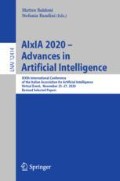Abstract
Hybrid algorithms are powerful search algorithms obtained by the combination of metaheuristics with other optimization techniques, although the most common hybridization is to apply a local solver method within evolutionary computation algorithms. In many published works in the literature, such local solver is run in different ways, sometimes acting on the perturbed elements and other on the best ones, and this raises the question of when it is best to run the local solver and on which elements it acts best in order to improve the reliability of the algorithm. Thus, three different ways of running local search in an immune algorithm have been investigated, and well-known community detection was considered as test-problem. The three methods analyzed have been assessed with respect their effect on the performances in term of quality solution found and information gained.
Access this chapter
Tax calculation will be finalised at checkout
Purchases are for personal use only
References
Blum, C., Raidl, G.R.: Hybrid Metaheuristics: Powerful Tools for Optimization. Artificial Intelligence: Foundations, Theory, and Algorithms. Springer, Heidelberg (2016). https://doi.org/10.1007/978-3-319-30883-8
Cutello, V., Fargetta, G., Pavone, M., Scollo, R.A.: Optimization algorithms for detection of social interactions. Algorithms 13(6), 139 (2020). https://doi.org/10.3390/a13060139
Cutello, V., Nicosia, G., Pavone, M.: An immune algorithm with stochastic aging and kullback entropy for the chromatic number problem. J. Comb. Optim. 14, 9–33 (2007). https://doi.org/10.1007/s10878-006-9036-2
Cutello, V., Oliva, M., Pavone, M., Scollo, R.A.: A hybrid immunological search for the weighted feedback vertex set problem. In: Matsatsinis, N.F., Marinakis, Y., Pardalos, P. (eds.) LION 2019. LNCS, vol. 11968, pp. 1–16. Springer, Cham (2020). https://doi.org/10.1007/978-3-030-38629-0_1
Cutello, V., Oliva, M., Pavone, M., Scollo, R.A.: An immune metaheuristics for large instances of the weighted feedback vertex set problem. In: 2019 IEEE Symposium Series on Computational Intelligence (SSCI), pp. 1928–1936, December 2019. https://doi.org/10.1109/SSCI44817.2019.9002988
Danon, L., Díaz-Guilera, A., Duch, J., Arenas, A.: Comparing community structure identification. J. Stat. Mech: Theory Exp. 2005(09), P09008–P09008 (2005). https://doi.org/10.1088/1742-5468/2005/09/p09008
Di Stefano, A., Vitale, A., Cutello, V., Pavone, M.: How long should offspring lifespan be in order to obtain a proper exploration? In: 2016 IEEE Symposium Series on Computational Intelligence (SSCI), pp. 1–8, December 2016. https://doi.org/10.1109/SSCI.2016.7850270
Didimo, W., Montecchiani, F.: Fast layout computation of clustered networks: algorithmic advances and experimental analysis. Inf. Sci. 260, 185–199 (2014). https://doi.org/10.1016/j.ins.2013.09.048
Fortunato, S., Barthélemy, M.: Resolution limit in community detection. Proc. Natl. Acad. Sci. 104(1), 36–41 (2007). https://doi.org/10.1073/pnas.0605965104
Fouladvand, S., Osareh, A., Shadgar, B., Pavone, M., Sharafi, S.: DENSA: an effective negative selection algorithm with flexible boundaries for self-space and dynamic number of detectors. Eng. Appl. Artif. Intell. 62, 359–372 (2017). https://doi.org/10.1016/j.engappai.2016.08.014
Girvan, M., Newman, M.E.J.: Community structure in social and biological networks. Proc. Natl. Acad. Sci. 99(12), 7821–7826 (2002). https://doi.org/10.1073/pnas.122653799
Gulbahce, N., Lehmann, S.: The art of community detection. BioEssays 30(10), 934–938 (2008). https://doi.org/10.1002/bies.20820
Hubert, L., Arabic, P.: Comparing partitions. J. Classif. 2, 193–218 (1985). https://doi.org/10.1007/BF01908075
Kernighan, B.W., Lin, S.: An efficient heuristic procedure for partitioning graphs. Bell Syst. Tech. J. 49(2), 291–307 (1970). https://doi.org/10.1002/j.1538-7305.1970.tb01770.x
Kullback, S.: Statistics and Information Theory. Wiley, Hoboken (1959)
Lancichinetti, A., Fortunato, S.: Benchmarks for testing community detection algorithms on directed and weighted graphs with overlapping communities. Phys. Rev. E 80 (2009). https://doi.org/10.1103/PhysRevE.80.016118
Lancichinetti, A., Fortunato, S., Radicchi, F.: Benchmark graphs for testing community detection algorithms. Phys. Rev. E 78 (2008). https://doi.org/10.1103/PhysRevE.78.046110
Meilă, M.: Comparing clusterings-an information based distance. J. Multivar. Anal. 98, 873–895 (2007). https://doi.org/10.1016/j.jmva.2006.11.013
Newman, M.E.J., Girvan, M.: Finding and evaluating community structure in networks. Phys. Rev. E 69 (2004). https://doi.org/10.1103/PhysRevE.69.026113
Pavone, M., Narzisi, G., Nicosia, G.: Clonal selection: an immunological algorithm for global optimization over continuous spaces. J. Glob. Optim. 53, 769–808 (2012). https://doi.org/10.1007/s10898-011-9736-8
Vitale, A., Di Stefano, A., Cutello, V., Pavone, M.: The influence of age assignments on the performance of immune algorithms. In: Lotfi, A., Bouchachia, H., Gegov, A., Langensiepen, C., McGinnity, M. (eds.) UKCI 2018. AISC, vol. 840, pp. 16–28. Springer, Cham (2019). https://doi.org/10.1007/978-3-319-97982-3_2
Author information
Authors and Affiliations
Corresponding author
Editor information
Editors and Affiliations
Rights and permissions
Copyright information
© 2021 Springer Nature Switzerland AG
About this paper
Cite this paper
Scollo, R.A., Cutello, V., Pavone, M. (2021). Where the Local Search Affects Best in an Immune Algorithm. In: Baldoni, M., Bandini, S. (eds) AIxIA 2020 – Advances in Artificial Intelligence. AIxIA 2020. Lecture Notes in Computer Science(), vol 12414. Springer, Cham. https://doi.org/10.1007/978-3-030-77091-4_7
Download citation
DOI: https://doi.org/10.1007/978-3-030-77091-4_7
Published:
Publisher Name: Springer, Cham
Print ISBN: 978-3-030-77090-7
Online ISBN: 978-3-030-77091-4
eBook Packages: Computer ScienceComputer Science (R0)

